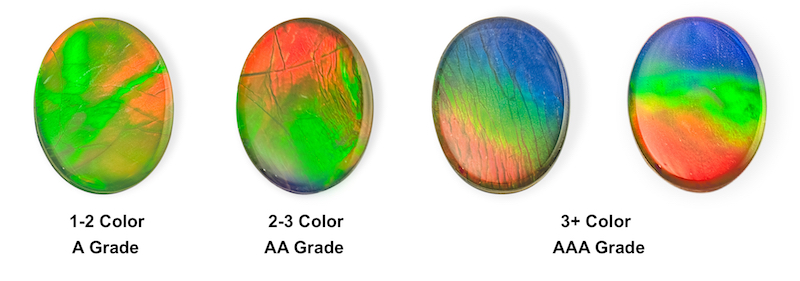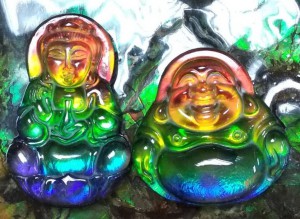GRADING
COLORS
Gemstone ammonite can be found in any color known in nature and the imagination of man. Or it could have an infinite array of color combinations in every square centimeter. The higher grades will have either a very strong, bright single color or contain a range of bright colors drawn from a color spectrum more vast than a rainbow, while lower grade gemstones will show less vibrant colors in a more limited range. Generally red/green is more common than blue or purple, but there are certain hues, like crimson or violet or gold, derived from any of the primary colors that are very rare and in high demand.
IRIDESCENCE
Ammonite shell is comprised primarily of aragonite with trace elements of aluminium, barium, chromium, copper, iron, magnesium, manganese, silicon, strontium, titanium and vanadium. The spectral property of the mineral aragonite that allows us to see the incredible play of colors across it’s surface is it’s iridescence. The shell surface is composed of closely packed, tabular, hexagonal crystals of aragonite oriented with their c-axis vertical to the shell surfaces and united into thin lamellae (plates or scales). The thickness of these lamellae is of the same magnitude as the wavelengths of the spectral colors which make up white light. Thus, when white light (sunlight) enters the regularly spaced thin layers of aragonite, diffraction occurs, and flashes of spectral colors are seen. As the plates of aragonite crystals vary in thickness with the addition of the trace elements which are randomly arranged and is interspersed with inclusions of organic material (conchiolin) the intensity of the diffracted colors also varies. The best ammonite shell will have brilliant, vibrant iridescence, continually dancing with changing colors as the angle of the incident light changes.

CHROMATIC SHIFT
The color of most gemstone ammonite changes dependent on the angle of light entering and the viewers perspective. Sometimes subtle, and sometimes spectacularly dramatic, a chromatic shift occurs. Most red will shift to green and most green will shift blue, etc. This is called dichromatic. Some gem material will have the shift restricted to hues within the same primary color group. This is monochromatic. The best gem material has spectrochromatic shift. Color will shift through the entire spectrum depending on light source and your angle of observation.
ROTATIONAL RANGE
With the iridescence and chromatic shift variations some material will not show strong, vibrant colors through 360° degrees of rotation. As the gemstone is rotated the brightness decreases and darkens to black. This is due to the light wave diffraction being blocked by the organic inclusions in the aragonite. For a gemstone to be Graded AA+ it must show a brilliant color through 360° of rotation.



